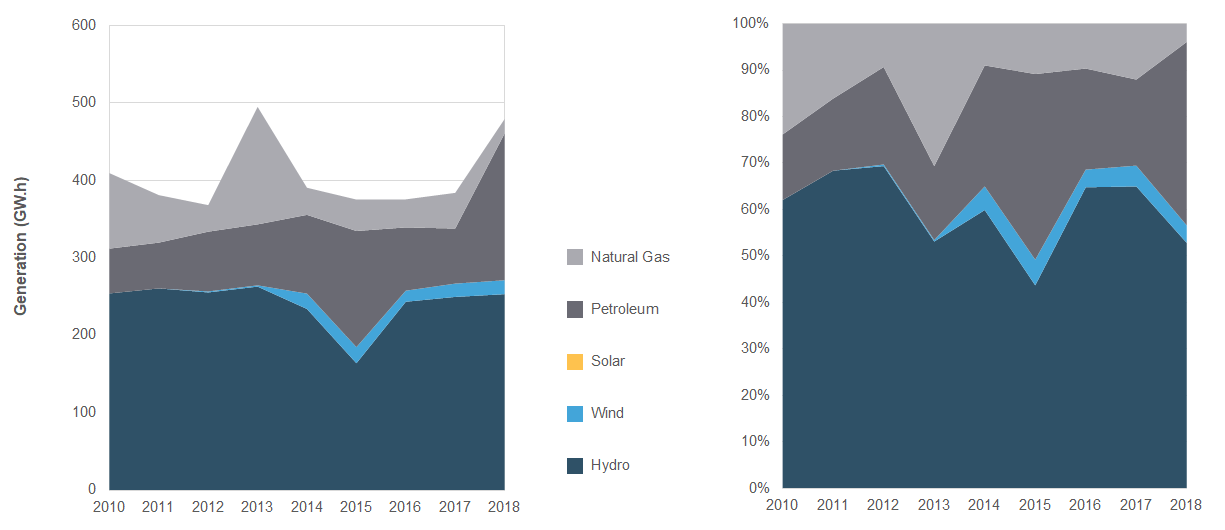Canada's Renewable Power – Northwest Territories

Northwest Territories

Two hydro-based grids in the Northwest Territories (NWT) meet the majority of the territory’s electricity demands, though numerous remote communities and mines rely entirely on fossil fuel generation. New renewable projects are helping the territory reduce its reliance on diesel fuel and lower costs for residents.
Generation Trends
In most years, the majority of NWT’s electricity is generated through hydro. In 2018, 253 gigawatt-hours (GW.h) of hydro was generated in the territory, providing 52.8% of the territory’s electricity. Hydroelectric generation fluctuates significantly between years in NWT depending on water conditions. The Snare, Bluefish, and Taltson hydro plants provide power to the areas around Great Slave Lake.
Four wind turbines at the Diavik Diamond Mine produced 3.8% of NWT’s electricity generation in 2018. The wind turbines only provide power to the mine and are not connected to any communities or regional grids in NWT. Total renewable generation in 2018 was 271 GW.h, or 56.6% of total generation.
Diesel-fired generation fluctuates annually, meeting demand not met by hydro or varying with mining activity. Diesel-fired generation is also used in most of NWT’s remote communities that are not connected to one of the territory’s hydro-based grids. Inuvik relies on one natural gas generator in addition to a diesel generator. The natural gas is imported by truck, in the form of liquefied natural gas (LNG). Natural gas use has been falling since 2005, partly because natural gas production in NWT has declined. Total thermal generation in 2018 was 208 GW.h, or 43.4% of total generation.
Total electricity generation in NWT increased from 409 GW.h in 2010 to 479 GW.h in 2018. Changes in NWT’s electricity generation mix are illustrated in Figure 1.
Figure 1. Electricity Generation in NWT

Source and Description
Source: CER – Canada’s Energy Future 2020 (EF2020)
Description: This graph illustrates electricity generation from 2010 to 2018 in NWT. In 2010, NWT’s total generation was 409 GW.h (62.1% renewable). In 2018, total generation was 479 GW.h (56.6% renewable).
GHG Emissions from Electricity Generation
In 2018, NWT’s electricity sector emitted 0.07 megatonnes of carbon dioxide equivalent (MT of CO2e). NWT’s generation intensity was 160 grams of CO2e per kilowatt-hour.
NWT produced 0.1% of Canada’s total greenhouse gas emissions from electricity generation in 2018.
Recent and Projected Capacity Changes for Renewables
Between 2010 and 2017, NWT added a net 11 megawatts (MW) of renewable capacity, primarily from wind (9.2 MW). Between 2017 and 2023, NWT is projected to lose 6 MW of net renewables capacity. These capacity changes are illustrated in Figure 2 with data provided in Table 1.
The loss of capacity is primarily from the expected closure of the Diavik Diamond Mine in 2023.Footnote 1 The closure will result in the loss of 9.2 MW of wind capacity.
A total of 2.9 MW of new hydro, solar, and wind energy sources are projected by 2023. The Inuvik Wind Energy project received $40 million in funding in 2019. In addition to the turbines, the project will involve battery storage to mitigate the intermittent nature of wind energy on Inuvik’s microgrid.
Figure 2. Electricity Capacity and Future Changes in NWT

Source and Description
Source: CER – EF2020
Description: This graph illustrates historical electricity capacity from 2010 to 2017 in NWT and the CER’s projection of future capacity changes from 2017 to 2023. In 2010, NWT’s total installed electricity capacity was 183 MW (30.4% renewable). In 2017, capacity had grown to 198 MW (33.6% renewable). By 2023, total capacity is projected to decline to 167 MW (35.9% renewable).
Table 1. Electricity Capacity (2010 – 2023) and Generation (2010 and 2018) in NWT
| Capacity in MW and % | Generation in GW.h and % | ||||||
|---|---|---|---|---|---|---|---|
| 2010 | 2017 | 2018 | 2020 | 2023 | 2010 | 2018 | |
| ---------- Projected ---------- | |||||||
| Hydroelectricity | 55 | 55 | 55 | 55 | 56 | 254 | 253 |
| 30.4% | 28.1% | 26.7% | 25.5% | 33.5% | 62.1% | 52.8% | |
| Wind | 0.0 | 9.2 | 9.2 | 9.2 | 2.0 | 0.0 | 18.0 |
| 0.0% | 4.7% | 4.4% | 4.2% | 1.2% | 0.0% | 3.8% | |
| Solar | 0.0 | 1.6 | 2.0 | 2.0 | 2.0 | 0.0 | 0.0 |
| 0.0% | 0.8% | 1.0% | 0.9% | 1.2% | 0.0% | 0.0% | |
| All Renewable Sources | 55 | 66 | 67 | 67 | 60 | 254 | 271 |
| 30.4% | 33.6% | 32.1% | 30.6% | 35.9% | 62.1% | 56.6% | |
| Natural Gas | 27 | 27 | 27 | 27 | 27 | 97 | 19 |
| 14.9% | 13.8% | 13.1% | 12.5% | 16.3% | 23.8% | 3.9% | |
| Oil and Diesel | 100 | 104 | 114 | 124 | 80 | 58 | 189 |
| 54.7% | 52.7% | 54.8% | 56.9% | 47.9% | 14.1% | 39.5% | |
| All Thermal Sources | 127 | 131 | 141 | 151 | 107 | 155 | 208 |
| 69.6% | 66.4% | 67.9% | 69.4% | 64.1% | 37.9% | 43.4% | |
| All Sources | 183 | 198 | 208 | 218 | 167 | 409 | 479 |
- Date modified:
